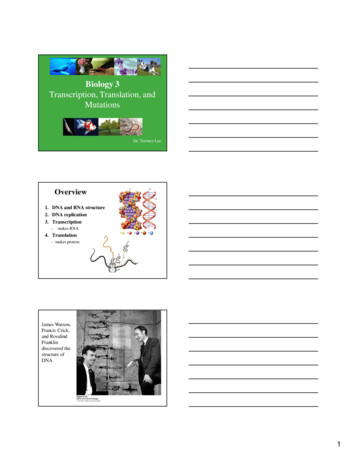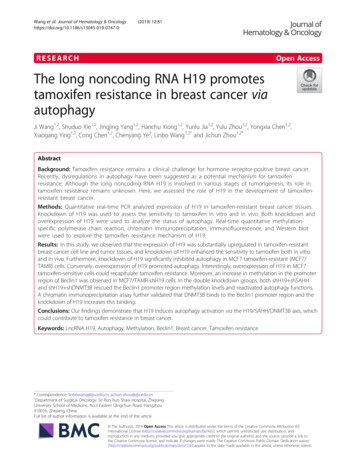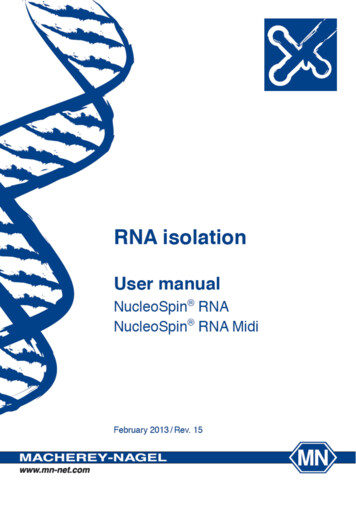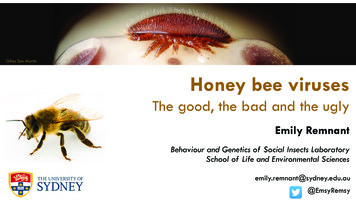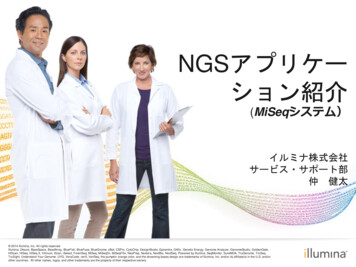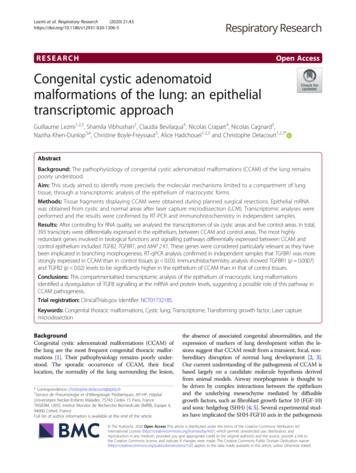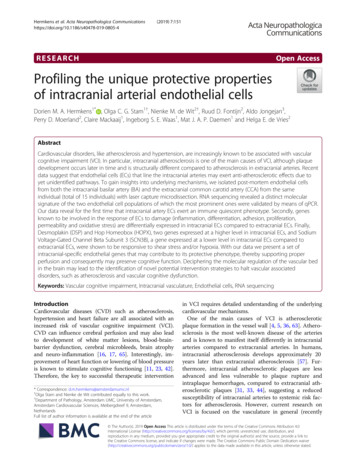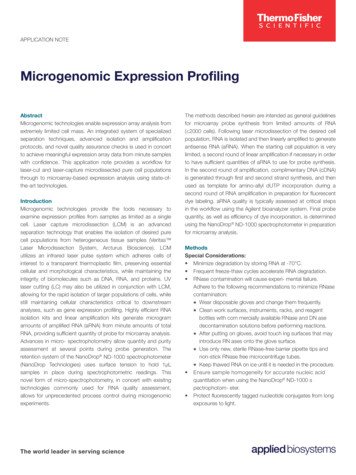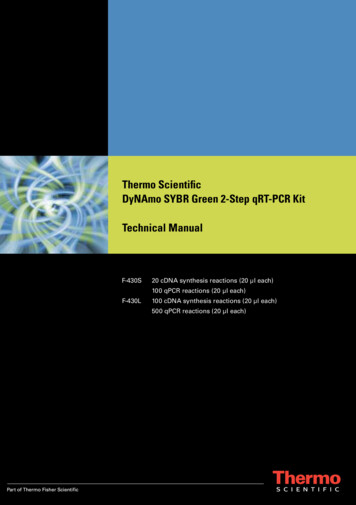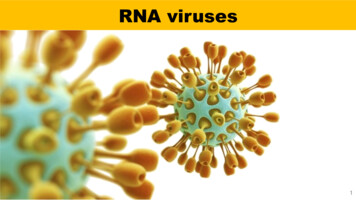
Transcription
RNA viruses1
RNA virusesCoronaviruses belong to a large family of RNA viruses thatcause many diseases in humans - from the common cold tosevere acute respiratory syndrome (SARS).Typical symptoms of RNA viruses include fever, cough, orshortness of breath. Pneumonia often occurs, and in severecases, with a weak immune response to infection,respiratory arrest may occur.In some patients, the function of other organs may beimpaired, but most often kidney failure or septic shockdevelops.2
RNA virusesIn most cases, RNA viruses cause complications,more severe course or progression of diseases,including the manifestation or progression of previouslyexisting diseases, in people with weakened immunity orthe progression of chronic diseases, especially in theelderly.This mainly concerns people with cardiovascular diseases,diabetes, chronic respiratory diseases, hypertension orpeople with oncology.3
RNA virusesHowever, it is not uncommon for people infected with the virusto almost never experience any serious or specific symptoms. Inthese cases, early detection of an RNA virus infection is notalways possible. However, symptoms of infection may occurwithin 14 days.The use of standard and specific immunostimulating andimmunomodulating procedures, methods and means ofpreventing the development of infection (prevention), in myopinion, more effective than treating an existing infectiousinfestation.4
RNA virusesTypical schematic structure ofthe RNA virusSpikeVirus shell RNA (genome)Proteins MProteins E5
RNA virusesAttachment of the RNAvirus with its spikes to theouter surface of the cellmembrane of the host cell(via ACE2 protein)At this stage, the virus isstill vulnerable to immunecells.6
RNA viruses7
RNA virusesRNA viruses interact with cells through Spike proteins (theso-called "spikes" on its surface).The genome of the virus consists of four components:1. Proteins S1 and S2;2. Component ectodomain;3. Transmembrane anchors;4. Short intracapsid tail.8
Novel Coronavirus Virus Genome (2019-nCoV)Proteins pp1ab and pp1a are non-structural cleavage products thatare involved in the transcription and translation of the viral genome:S - this is the spike protein of the virus (Spike)E - this is the membrane proteinM - this is the membrane proteinN - this is the nucleocapsid proteins9
RNA virusesIt is the ectodomain of the Spike protein that binds to theRBD domain of the ACE2 cell receptor. RBD (RNA BindingDomain) is the central nucleolin domain that contains fourconserved RNA binding domains, which in turn providefurther, specific interaction with nucleic acid sequences.In terms of amino acid composition, the Spike 2019-nCoVprotein is closest to the SARS-CoV protein.Their similarity corresponds to 76.5%.10
RNA virusesThe ability of coronaviruses topenetrate the host cells and causeinfection in the body is mediatedby the interaction of the thorn ofthe virus with the surfacereceptors of certain human cells.11
RNA virusesIt is important to note that 2019-nCoV (Novel Coronavirus)and COVID-19, the viruses that caused the latestepidemiological outbreak, use the same ACE2 cell entryreceptor as SARS-CoV.Thus, the human ACE2 protein is, as it were, the main“gateway” for the entry of RNA viruses into the host cell.12
RNA virusesVirus variations can cause structural rearrangements that allownew and possibly even faster and denser subsequentinteractions with ACE2.The 2019-nCoV coronavirus has been suggested that a singleN501T mutation in a Spike protein is related to SARS-CoV-2, butwith significantly increased binding to ACE2.Given this, it is unlikely that the SARS spike protein mutatedduring the 2002-2004 epidemic, so that only in 2019-2020, itwould be better to start binding to only certain receptors on thehuman cell surface.13
RNA virusesCoronavirus Spike proteins are trimers of type Itransmembrane protein that protrude from the surface ofthe virions.The subunit S1 of the ectodomain mediates the binding ofthe virion to the receptors of the surface of the host cellthrough its receptor-binding domain (RBD) - the bindingbridge.Subunit S2 fuses with both the host cell and viralmembranes, creating dramatic structural changes andmutations.14
The penetration of the virus into the cell using S protein:1. Intracellular space2. Virus3. Virus envelope4. Cellular5. N-acetyl neuraminic acid6.ACE2 receptor (ACE2 coronavirus receptor is anangiotensin-converting enzyme II receptor that is found inthe cells of the pulmonary alveolar epithelium, smallintestine enterocytes, in endothelial cells of arteries andveins).7. Maceous processes (S-surface glycoprotein, penetratesinto the cell).8. E envelope proteins (assembly and exit)9. Genome RNA approximately 30,000 nt long10. Port or channel of penetrationExplanation: RNA contains a cap structure and a polyA sequence. Capping is necessary to initiate proteinsynthesis, and the initiating nucleotide is recognized by the ribosome only if a cap is present.Also, the cap structure is a protection against rapid degradation. The polyA sequence is necessary so as not to berecognized by intracellular immune response systems that destroy RNA without such structures.15
Cellular reproduction of RNA viruses1.1. Since coronaviruses have one positive RNA genome withchains, they can directly produce their proteins and newgenomes in the cytoplasm. First, the virus synthesizes its RNApolymerase, which only recognizes and produces viral RNA.This enzyme synthesizes the negative chain using the positivechain as a template.2. Subsequently, this negative chain serves as a template fortranscription of smaller subgenomic positive RNAs that areused to synthesize all other proteins. In addition, this negativestrand serves to replicate new positive strand genomic RNAs.3. Protein N binds genomic RNA, and protein M integrates intothe membrane of the endoplasmic reticulum (ER), like theenvelope proteins S and HE. After binding, the assemblednucleocapsids with spirally twisted RNA are released into theER lumen and enclosed in the membrane.4. Trans-locator.5. The resulting viral offspring is transported by Golgi vesicles tothe cell membrane and exocytosed into the extracellular space.16
RNA viruses their encoding and survivalThe Novel Coronavirus virus genome (2019-nCoV) has fourunusual protein insertion sequences.The comparison showed that they are not present in anyother strains of coronavirus, but show identity / similaritywith rapidly changing amino acid sequences (they differ bya quick change in the length of the amino acid sequence),which leads to a significant increase in the level ofreplication of the virus and indicates an increase in itsadaptability.17
RNA viruses their encoding and survivalThese inserts add extra flexibility to RBD by forming ahydrophilic loop that provides a host-virus interaction withgreater infectivity. It is worth noting that their presence "isunlikely to be random in nature."So, it can be speculated that 2019-nCoV (SARS-CoV-2) was“specially designed” with additional sequences of codoncoding region inserts.18
RNA viruses their encoding and survivalHowever, given that these inserts appear in thehypervariable regions of the protein and have a length ofonly 6 residues, it is still possible to assume that theycould arise naturally.Therefore, in the future, to confirm or refute one of theabove options, various comprehensive studies of cellularimmune responses for these strains of coronaviruses 2019nCoV (SARS-CoV-2), COVID-19 will be required.19
RNA viruses their encoding and survivalThe coding regions consist of codons that follow directly oneafter another in sequences of three nucleotides, each of whichcorresponds to a specific amino acid in the genetic code i.e. thebeginning and end of protein synthesis. Coding regions beginwith a start codon and end with one of three stop codons.Reading of the codon sequence and assembly on its basis of theamino acid sequence of the synthesized protein molecule iscarried out by ribosomes with the participation of transport RNAin the translation process.In addition to coding for proteins, portions of coding regions canalso serve as control sequences.20
RNA viruses their encoding and survivalThe survival strategy of all viruses is based on "avoiding" the host'sadaptive immune response. To do this, they have a set of specialmechanisms. In particular, avoiding the VTLT immune response isbased on preventing the recognition of corresponding epitopes byimmune cells.An epitope, or antigenic determinant, is part of an antigenmacromolecule that is recognized by antibodies as well as Blymphocytes and T-lymphocytes of the immune system.Like other Spike coronaviruses, the 2019-nCoV protein (SARS-CoV-2)induces a series of neutralizing antibodies, causing disturbances in theresponse of cytotoxic T-cell immunity.21
Cytotoxic T cell immunityCytotoxic T-cell immunity is important in preventing thedevelopment of viral infection and mitigating its severity.The regulation of the mechanisms of induction of virusspecific CD8 T-lymphocytes (VTTL) in humanscontributes to the improvement of prophylactic effectsagainst infection.CD8 play an important role in controlling viral infectionsthrough the cytolytic destruction of infected cells, followedby their elimination from the body.22
Cytotoxic T cell immunityWith respect to influenza infection, the role of VTsTL in reducingthe severity of the disease and preventing infection, as inexperimental experiments in mice, has been proven (Taylor P.M.,Askonas B.A. Influenza nucleoprotein-specific cytotoxic T-cellclones are protective in vivo. Immunology. 1986), so whenvolunteers become infected (McMichael A.J., Gotch F.M., NobleG.R., Beare P.A. Cytotoxic T-cell immunity to influenza. N.Engl. J. Med. 1983).23
Cytotoxic T cell immunityThe main targets for VTsTL are immunodominant epitopesof the internal proteins of RNA viruses present on thesurface membrane of infected cells.Nevertheless, it must be emphasized that althoughneutralizing antibodies can prevent the penetration of thevirus, the body also needs T helper cells to producespecific antibodies, as well as to recognize and destroyinfected cells, especially in the lungs of infected people.24
Interleukin-2 (IL-2)Interleukin-2 ( IL-2) is a peptide of one of the types ofcytokines, which is a mediator of inflammation and at thesame time a mediator of immunity.It is produced by T cells in response to antigenic andmitogenic stimulation.IL-2 is necessary for the proliferationof next generations of T cells and other processes thatregulate the immune response.25
Interleukin-2 (IL-2)Interleukin-2 is the main cytokine in the family ofinterleukins IL-4, IL-7, IL-9, IL-15, IL-21.All of these interleukins act via the IL-2 alpha receptor(CD25) or the IL-2 beta receptor (CD122).Activation of IL-2 is vital for the development andfunctioning of lymphocytes.26
Interleukin-2 (IL-2)Interleukin-2 also activates signaling pathways:1.Ras / MAPK (survival, proliferation and increased cell motility);2.JAK / Stat (gene expression, which stimulates blood renewal, theemergence of immune cells and fat cells, participates in theprocess of cell division and death, plays a major role in thetransmission of cytokine receptor signals);3.PI 3-kinase / Akt (growth, proliferation, differentiation, motility andsurvival of cells, as well as regulation of intracellular metabolism /is especially important in oncology).27
PREVENTAVIRDietary supplement PREVENTAVIR (another name forthe product is IMMUBOO supplement) contains 100%natural ingredients that have undergone exclusivedouble extraction technology from medicinalmushrooms and brown poppy root with the addition ofPROVEOTICS probiotics.The mixture contains: Grifolinacid, Triterpenes,Crystalline amino acids Ifidobacterium longum,Streptococcus thermophilus, a mixture ofLactobacillus (acidophilus, bulgaricus, rhamnosus,fermenti, helveticus, paracase)www.bioono.com28
PREVENTAVIRThe dietary supplement PREVENTAVIR,(supplement IMMU BOO) was tested in alaboratory of the Department of Pathology atthe University of Louisville, Kentucky, USA.The experimental data obtained during thestudies allowed us to conclude withconfidence that glucans of the dietarysupplement PREVENTAVIR are highly activeimmunostimulants.29
PREVENTAVIRStudies of phagocytosis (both inperitoneal macrophages and inneutrophils and blood monocytes)have shown that takingP R E V E N TAV I R s u p p l e m e n t screates significant stimulatingactivity in all types of cells.30
PREVENTAVIRSimilar results were obtained whenmeasuring the production of IL-2.The production of IL-2 without anystimulation in the body is usuallyvery low (sometimes even equal to0), therefore, the observedproduction of IL-2 when takingPREVENTAVIR is very significant.31
PREVENTAVIRA study was conducted on thepossibility of stimulation by theaddition of PREVENTAVIR antibodyresponse. It has been confirmedthat taking an already daily dosesignificantly improved antibodyresponse (compared to Ag).32
PREVENTAVIR - study findingsThe immunostimulating activity of the test sample for cellular immunity(phagocytosis) was confirmed. An increase of 30–40% was observed incomparison with the control sample without the use of an additive.The immunostimulating activity of the test sample on humoral immunity wasconfirmed. There was a 30–40-fold increase in antibody production andsecretion of IL-2, compared to the standard response.A 200-300% increase in antibody production was confirmed in comparisonwith the control Ag. A slight increase in own stem cell production by 5-10%was confirmed !!!However, statistically it is difficult to give a proper assessment due to theshort testing period.Department of PathologyUniversity of Louisville School of MedicineDate: 28 day of October, 201933
Coronavirus Information“COVID-19 Medial Hysteria” is more like an informationepidemic.We are told that the epidemic is growing uncontrollably.Every day, the numbers of statistics (infected and dead)change.The following will be the official information and in someplaces my own opinion or explanation.Everyone can make conclusions himself!34
Coronavirus InformationBut first, I’ll ask you to pay attention in advance to certainhighlighted dates, statistical numbers in them and / or eventsaccompanying them. So. It all started on December 12, 2019 inWuhan, Hubei Province, China (Wuhan City, Hubei Province ofChina).An outbreak of infection caused by an unknown virus hasoccurred. In five patients, at an early stage of the outbreak, fulllength genome sequence samples were obtained for the newvirus.They were almost identical to the sequences for SARS-CoV.35
Coronavirus InformationThe highlighted virus wasgiven the name NovelCoronavirus (2019-nCoV) andthe history of the epidemichas begun.However, official statisticsfrom the World HealthOrganization (WHO) are onlyavailable fromJanuary 21, 2020.36
Coronavirus Information11.02.2020WHO was “not satisfied” with the Chinese name of thevirus and officially adopted its name, both the virus andthe name of the epidemic itself - -on-2019-ncov-on-11-february-2020].37
Novel Coronavirus epidemic or .38
. COVID-1939
The total number of confirmed cases in the world of Novel Coronavirus (2019-nCoV)40
Novel Coronavirus (2019-nCoV) . COVID-1913.02.2020One day after renaming, an inexplicable increase indeaths occurs .Check for yourself the average increase in deaths per dayand you will see that 02/13/2020 is very strangely differentfrom these deaths before . and even after that date.41
Total confirmed cases worldwide Coronavirus disease 2019 (COVID-19)42
Novel Coronavirus (2019-nCoV) . COVID-19Noteworthy is the following date 02/17/2020On this day,not mortality is increasing . but the number of confirmedcases of infection is growing incredibly and inexplicably This coincided with the statement of the previous dayabout "Waiting for a large possible growth of theCOVID-19 epidemic (including in Europe)"43
Novel Coronavirus (2019-nCoV) . COVID-1919.02.2020Total mortality is kept at 2.3%. The highest mortality rateis found in people over 80 years old - 14.8%.In people from 70 to 80 years, mortality is - 8%.In the group of people 10-40 years old, mortality is 0.2%.Not one child aged 0-9 years has died.44
Novel Coronavirus (2019-nCoV) . COVID-1903/01/2020The number of new cases of infection with COVID-19coronavirus outside of China for the first time exceededthe number of cases in China itself.From 02.03.2020 the statistics tables are presenteddifferently (mortality over the past 24 hours in China isshown, and the development of COVID-19 outside ofChina is shown in more detail)45
ChinaMortality 3,7%46
Countries, territories or areas outside ChinaBy early March, deaths from COVID-19 outside China 1.7%47
Incidence / MortalityAmong healthy people under the age of 50, the mortalityrate from Novel Coronavirus (2019-nCoV) / COVID-19 isquite low.And in older patients, the mortality rate is much higher.Available data indicate that the mortality rate in olderpeople and people with cardiovascular diseases,diabetes and cancer, as well as in patients withimmunodeficiency syndrome, is higher and rangesfrom 9 to 19% (information from a WHO briefing on03/09/2020)48
Incidence / MortalityThe percentage of deaths from the anamnesisAnamnesisCardiovascular diseasesMortality19,5%DiabetesChronic respiratory r: 29,9%49
ComparisonIn the period 2017-2018.About 650,000 people died from common flu in the world.V období2017–2018zemřelo 650-000lidí.A nebylato pandemie- bylato jenAnd itepidemiewas nota pandemicitwasacommonflu.InthechřipkaUSA, during the fall-spring 2019-2020 (until early March),8,200 people died from RNA viruses.And how much is from COVID-19?Infected 62 people, died - 0 .?50
ComparisonAge-specific incidence statistics for COVID-19V období epidemie 2017–2018 zemřelo 650 000 lidí. A nebyla to pandemie - byla to jenchřipka51
SARS/ТОРС or MERS-CoVTo date, mortality from Coronavirus COVID-19 (about5.4%) is lower than, for example, from SARS / SARS(SARS, which arose in 2003).Then mortality was 9.6%. Mortality in Coronavirus 2012Middle East respiratory syndrome (Middle Eastrespiratory syndrome coronavirus MERS-CoV) was 36%.52
COVID-19 - no panic!For most people, COVID-19 can be just an infection, albeitan aggressive but not fatal infection. However, with aweak immune response, more serious complications canarise, including life risks and death.This is especially true for older people as well as peopleat risk with chronic diseases of the cardiovascularsystem, respiratory diseases or diabetes.53
COVID-19 - no panic!It must be remembered that if you are in an area whereCOVID-19 infections have indeed been confirmed, you shouldbe more serious about the potential risk of infection and takeappropriate measures to protect yourself and your family,including maximizing the potential for preventive measures.54
COVID-19 - solidarity and responsibilityEach person infected with seasonal flu can infect approximately 1.3other people. SARS-CoV-2 (the virus that causes COVID-19) infectsabout three times as many people (according to current spreadestimates, up to 4 people).This number of infections is called the reproductive factor, or "R0."This propagation speed allows the current coronavirus to multiply veryquickly. Such breeding between people and their infection can lead toan overload of an already busy healthcare system.55
COVID-19 - solidarity and responsibilitySo, even if you yourself are not at a high risk of morbidity,from a public point of view and solidarity it is necessaryto take measures that will prevent the spread of the virus.It must be borne in mind that the rapid increase in thenumber of sick people can lead to an overload of thehealth system, as is happening now in Italy.56
COVID-19 - solidarity and responsibilityDo not be a person who spends medical and hygieneresources that someone may need more than he needs. This isa matter of ethics and humanity.We must minimize the spread of the virus so that health careresources (from diagnosis and treatment, to respirators andoxygen devices) are available to the people who need themmost.Slower distribution will save many lives, because a nonoverloaded health system will be able to provide timelyassistance in full to those who need it most.57
COVID-19 - Useful TipsKeep a minimum distance of 1.5 meters from people who havea persistent cough, runny nose and / or fever. If possible, donot touch your eyes, nose, and mouth with your hands beforehandling your hands.So, as the hands touch many surfaces on which the virus maybe present. If you touch your eyes, nose, or mouth with yourhands, you can transfer the virus from your skin to your body.Follow the rules of respiratory hygiene. When coughing andsneezing, cover your mouth and nose with a tissue,handkerchief, or hand.58
COVID-19 - Useful TipsThis virus, as already mentioned, has a high reproductivefactor (R0) and a high prodromal (asymptomatic or incubation)period - which is about 14 days.Do not forget that some people can be carriers of RNA viruseswithout symptoms.Apparently, the coronavirus can go into a "sleeping" or inactivemode.However, in the fall, he can continue all over again and amazenew people.59
COVID-19The largest foci ofCOVID-19 development sofar have arisen in the socalled cooler areas of theworld. However, one mustunderstand the virus doesnot respond to heat, but tothe power of direct sunlight(body temperature is about37 C and the virus easilysurvives with it)60
COVID-19 - Useful TipsThe problem of COVID-19 is not so much mortality as theoverall impact of an infectious outbreak.Although other diseases can be more fatal, the combination ofthe reproductive factor (R0) and the susceptibility of apopulation where immunity is an important factor cannot beunderestimated.It must be borne in mind that this SARS-CoV-2 strain (the virusthat caused Novel Coronavirus (2019-nCoV) / COVID-19) iscompletely new, so no one is safe.61
COVID-19 - Useful TipsThere is no clinical trial of a valid vaccine for this strain of thevirus. According to experts, its development, verification andimplementation will require enough time.Estimated dates not earlier than the 1st quarter of 2021. Sowhile the best protection remains - the prevention of theimmune system, hygiene, alcohol-based disinfection(70-90%).However, it must be understood that disinfectants can onlyslow down the virus, but not make it completely powerless.62
COVID-19 - Useful TipsMost likely, in March and April 2020, thepandemiological situation will not change.Perhaps in May and June the epidemic willbegin to decline.But given that the vaccine will not be before2021, several more epidemiologicaloutbreaks may well occur.How thecoronavirus behaves further is a bigquestion.Nevertheless, we can doprophylaxis against it or other RNA viruses.For example, using PREVENTAVIR.63
COVID-19 - Useful TipsRemember that panic and fear do more harm than thecoronavirus itself.We must be realistic and at the same time be prepared forvarious possible consequences, correctly understand the bigpicture and the reality behind it and adequately respond bytaking reasonable actions.I emphasize just reasonable actions in order to minimize therisks that have already arisen.I WISH ALL HEALTH AND STRENGTH!64
transcription of smaller subgenomic positive RNAs that are used to synthesize all other proteins. In addition, this negative strand serves to replicate new positive strand genomic RNAs. 3. Protein N binds genomic RNA, and protein M integrates into the membrane of the endoplasmic reticulum (ER), like the envelope proteins S and HE.
